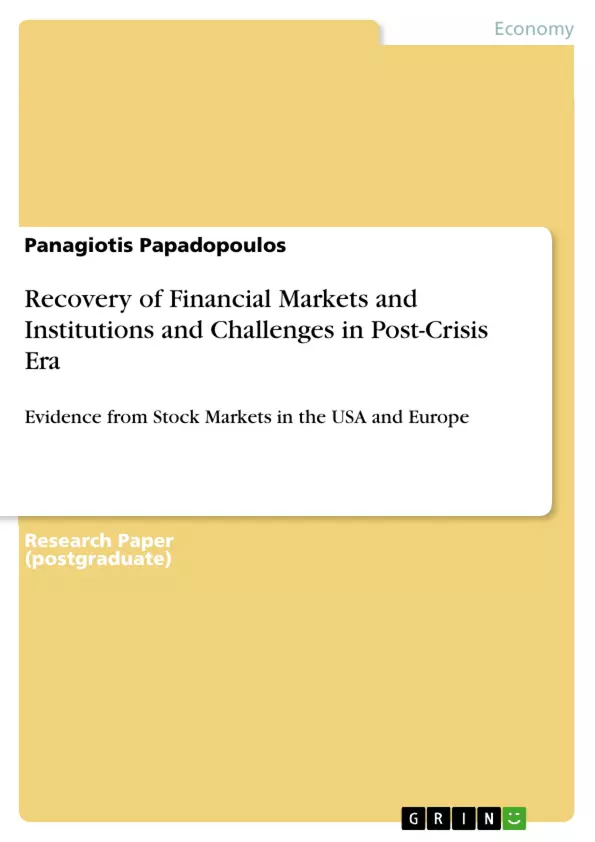This coursework examines the effects which the financial crisis from 2007 to 2009 had in financial markets and institutions. Particularly, we are deeply analyzing the impact in the Stock Markets in the USA and Europe. We will concentrate on US stock market (S&P 500) and provide an incessant brief link to European stock markets such as FTSE 100 and DAX. The financial crisis from 2007 to 2009 is considered by many economists to be the worst crisis since the Great Depression of the 1930s. Furthermore, the use of monetary and fiscal policies and regulatory reforms is observed as well as what where the implications of these actions. Additionally, a discussion concerning the prospects of financial regulatory and the implications for the financial sector and economic growth are of great importance. To sum up, new trends and developments of the financial landscape and new challenges for partici-pants are discussed.
Inhaltsverzeichnis (Table of Contents)
- Executive Summary
- Table of contents
- List of figures
- 1. Introduction
- 2. Effects of the financial crisis on Stock markets
- 3. Recovery process and political actions
- 3.1 Monetary policies
- 3.2 Fiscal policies
- 4. Financial regulatory reforms
- 5. New trends and challenges in the financial environment
- 6. Conclusion
- References
Zielsetzung und Themenschwerpunkte (Objectives and Key Themes)
This coursework examines the effects of the financial crisis from 2007 to 2009 on financial markets and institutions, with a particular focus on the impact on the Stock Markets in the USA and Europe. The coursework analyzes the use of monetary and fiscal policies, regulatory reforms, and the implications of these actions. It also discusses the prospects of financial regulatory and the implications for the financial sector and economic growth. Finally, it explores new trends and developments in the financial landscape and the challenges for participants.
- The impact of the 2007-2009 financial crisis on stock markets in the USA and Europe.
- The use of monetary and fiscal policies in response to the crisis.
- Financial regulatory reforms and their implications for the financial sector.
- New trends and challenges in the financial environment.
- The prospects for future financial stability and economic growth.
Zusammenfassung der Kapitel (Chapter Summaries)
- Introduction: This chapter introduces the financial crisis of 2007-2009 and its impact on global stock markets, highlighting the role of the US housing bubble collapse and the Lehman Brothers insolvency. It also discusses the consequences of the crisis, including declines in credit accessibility and damaged investor confidence.
- Effects of the financial crisis on Stock markets: This chapter analyzes the effects of the financial crisis on stock markets, particularly in the USA (S&P 500) and Europe (FTSE 100 and DAX). It examines the performance of these markets during the crisis and discusses the factors that contributed to their decline.
- Recovery process and political actions: This chapter examines the recovery process following the financial crisis and the political actions taken to address the crisis. It focuses on monetary policies, such as interest rate adjustments, and fiscal policies, such as government spending and tax cuts.
- Financial regulatory reforms: This chapter examines the financial regulatory reforms that were implemented in response to the financial crisis. It discusses the main provisions of these reforms and their impact on the financial sector.
- New trends and challenges in the financial environment: This chapter explores the new trends and challenges that have emerged in the financial environment following the crisis. It discusses the changing landscape of financial markets and the implications for participants.
Schlüsselwörter (Keywords)
Key terms and concepts explored in this coursework include the 2007-2009 financial crisis, stock markets, monetary policy, fiscal policy, financial regulation, economic growth, and the implications of these factors for the financial sector and the global economy. The coursework also focuses on the US and European stock markets, specifically the S&P 500, FTSE 100, and DAX.
- Quote paper
- Panagiotis Papadopoulos (Author), 2011, Recovery of Financial Markets and Institutions and Challenges in Post-Crisis Era, Munich, GRIN Verlag, https://www.grin.com/document/170221



